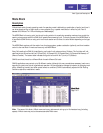
ERROR Count The number of calls processed by this Block which encountered a condition which SVMi-8 could not
recognize, or were terminated due to a processing error, and what percentage of the total calls this number repre-
sents.
NEXT Count The number of calls processed by this Block, during which the Block completed its function and the
caller was passed to the Target of the Next pointer, and what percentage of the total calls this number represents.
Speak Block
Description
AADDMMIINNIISSTTRRAATTIIVVEE TTEESSTT TTOOOOLL -- TTOO BBEE UUSSEEDD BBYY SSAAMMSSUUNNGG TTEECCHHNNIICCAALL SSUUPPPPOORRTT
Station Block
Description
The Station Block contains all the information needed to call or transfer a caller to a particular phone number . The
bulk of the Station Block defines the various call progress signals. It also contains any additional dial strings needed
to reach a particular station (like dialing '9' to access a trunk or adding digits after the call to activate a beeper).
One of the handiest features of the Station Block is the Call Progress Training facility. This feature allows you to pro-
vide phone numbers and have SVMi-8 call them to learn the ringback and busy signals automatically. The SVMi-8
then adjusts the appropriate parameter settings in the Station Block according to the data collected by calling the
provided numbers.
Blocks that reference a telephone number, such as Mailbox Blocks, must reference a Station Block which allows the
SVMi-8 to dial.
This is particularly useful for unique stations that must be handled in a special way. However, this usually isn't nec-
essary. Station Blocks contain a set of matching strings which allow the SVMi-8 to select an appropriate Station
Block based on the kind of number being dialed (all seven digit numbers, four digit numbers beginning with '3', '0',
long distance numbers, etc.). The SVMi-8 requires at least one Station Block to make supervised calls and you can
create as many Station Blocks as desired.
Station blocks can be specifically selected. If an instruction to dial a number (such as a message alert number or
pager notification - both found in the mailbox block) does not have a specific station block defined, a station block
will be automatically selected based on the number to dial. See Matching Dial Strings for more on this subject.
There are five types of Station Blocks preset on SVMi-8: Template, Beeper, Long Distance, Off-Premise, and On-
Premise.
Each of these Station Block types comes with factory preset settings which should not be changed. If you want to
change any of these parameter settings, press ‘Ctrl+A’ to bring up the Copy Block dialog. Enter a new name for the
Block and press ENTER. You now have a new Station Block. Make the necessary parameter setting changes to the
new Block and assign it as necessary. Save the original five Station Blocks with their factory default settings for
future reference and use.
Block Types and Descriptions
87


















